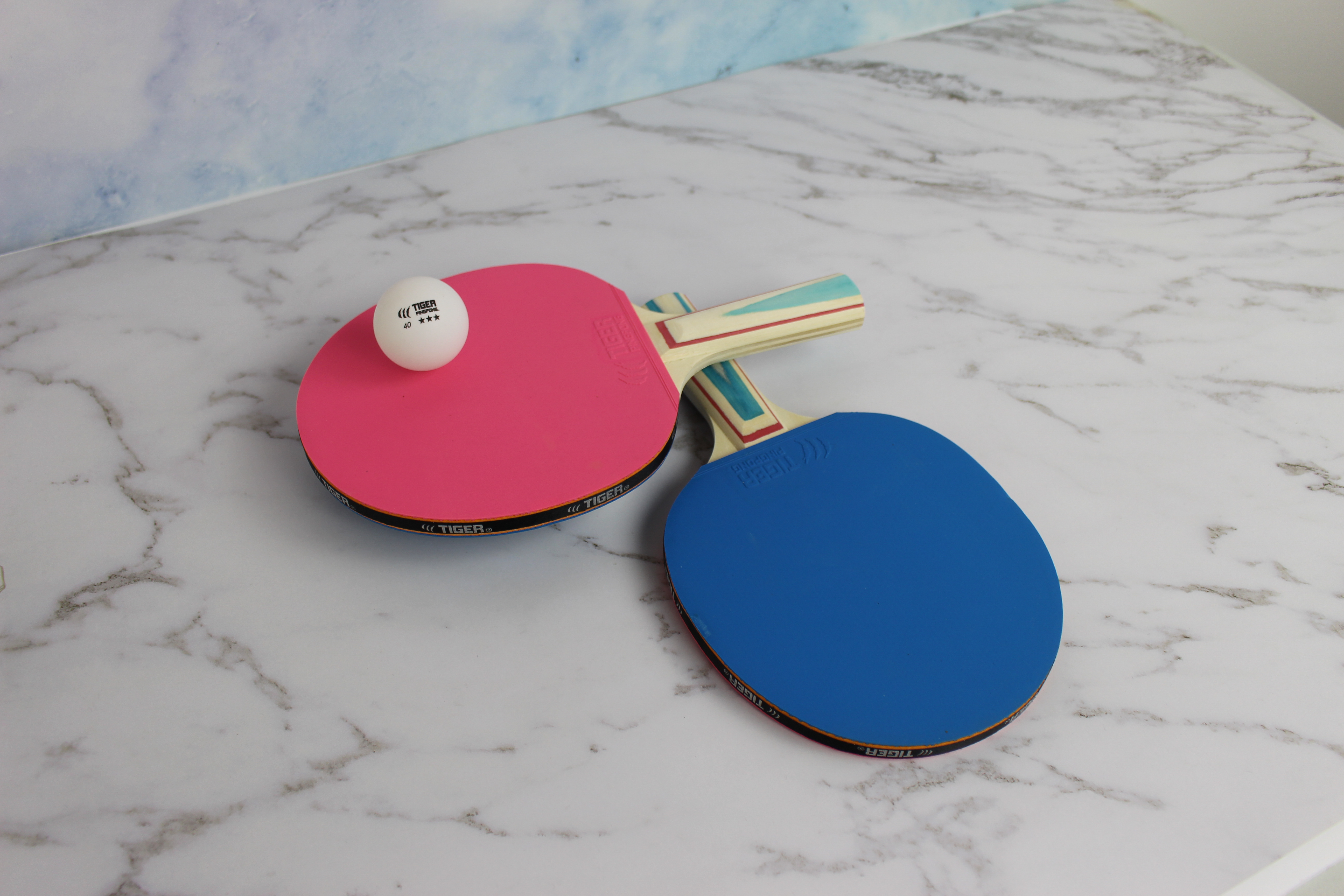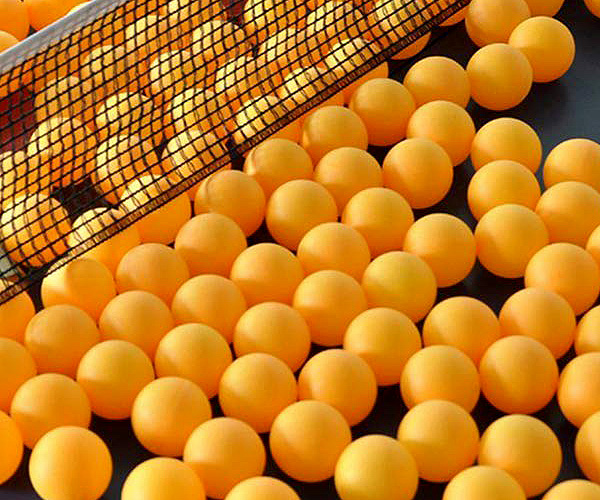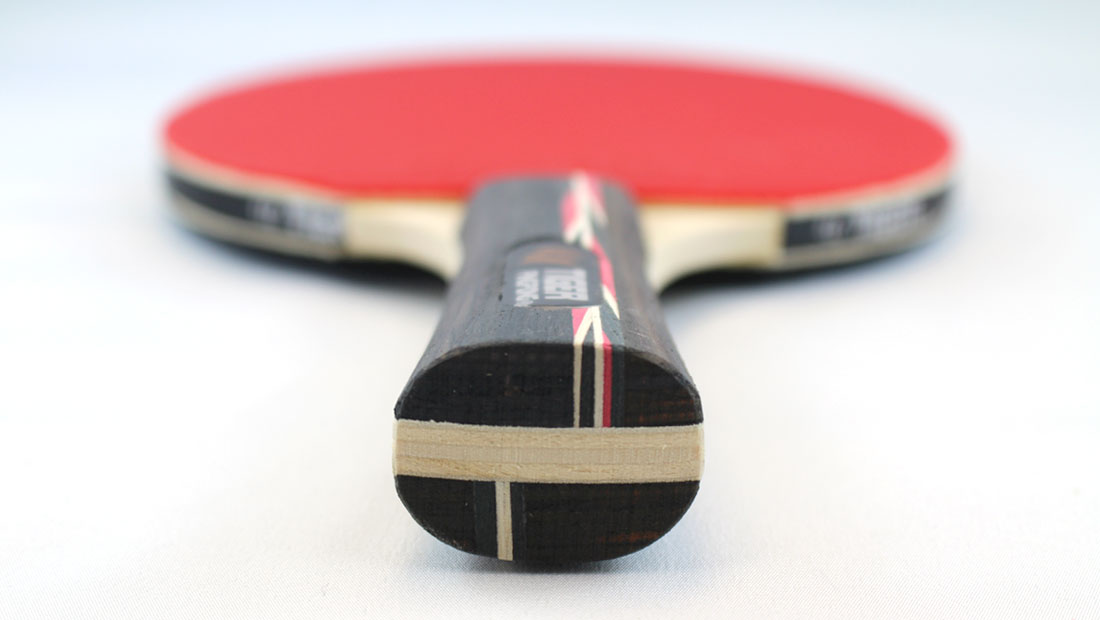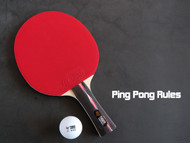Ping Pong Rules - Learn The Basics & Start Playing
Posted by Tiger PingPong on 6th May 2022
The Laws of Table Tennis
Official rules of table tennis, or to use their more official title - The Laws of Table Tennis - set by the International Table Tennis Federation are the same for both amateurs and professionals, BUT for higher levels of play, there are many additional regulations which supplement the simple ping pong rules explained below. How many additional regulations are used will depend upon the standard of the competition being played, and whether the organizers have adopted all or any of them.
For now, let's just take a look at a few of the basic ping pong rules you'll need to know in order to play a game with your friends.
The equipment

Table tennis table
The standard size of a ping pong table is 9' long by 5' wide and 2.5' high. This is the correct size of a competition playing surface. The rectangular playing surface should have two equal sides divided by a net in the middle. For a doubles match, each side should be divided into two equal half-courts separated by a white line.
Interestingly, the ping pong rules state that a ping pong table can be made of any material but a high-quality table tennis table is typically made of high-density fiberboard.
Net assembly
For your net assembly, it includes the net, suspension for the net, net post and clamp on each side. The top of the net should be 15.25 cm above the surface of the table, while the bottom of the net should be as near as possible to the playing surface.
Table tennis ball
Rules for professional ping pong balls are very specific. The standard ball should be spherical and have a diameter 40 mm. It should be made of plastic (like celluloid) and weigh 2.7 g. Colour-wise, the ball is supposed to be white or orange and matte to make it easy to see.
Ping pong racket
The final piece of equipment to get started with a match is your paddle (also known as a racket or bat). Rules regarding the ping pong paddle allow for some variation but the following guidelines should be met.
A racket blade can be any size or shape but must be flat, rigid and made of 85% natural wood material. The colour of your ping pong paddle must be black on one side and on the other side, it must be a vivid colour other than black and not match the ball colour.
Note that you must show your paddle to your opponent and umpire before a game and anytime you change your paddle. Each person (opponent and umpire) has the right to inspect your paddle.
How to start a game of ping pong
Before you start a game, you'll need to decide who's going to serve first.
If you're just playing a game with friends, you can use whatever method you like to decide this, but the official rules of table tennis say that it's decided by lot, usually by tossing a coin or disc with two distinct sides.
However, a common method at lower levels of play is for one player (or the umpire) to hide the ball in one hand, then put both hands under the table or behind their back, and then ask the opponent to guess which hand the ball is in. Although the winner of this usually serves first, he/she actually has three choices: elect to serve first, make the opponent serve first or choose which side of the table to play on when starting the match.
Then, if the winner of the lot chooses a particular end of the table to start play, his/her opponent then has the choice of whether to serve first or to make the opponent serve first. If the winner chooses to serve first, his/her opponent then has the choice of which end of the table he/she prefers to play at first.
The order of play in table tennis
In single-player matches, servers should serve correctly and the receiver should make a good return. Play continues to alternate until a point is won.
For doubles matches between two teams of two, a player serves to the opposing receiver, the receiver should return the serve and then the partner of the serving team should take the return and send it back to the partner of the receiver. This order continues until a point is won.
The service (serving rules)

Ping pong serving rules have been changed many times in recent years in relation to the service law, but for a casual game of table tennis, ping pong serving rules remain very simple.
The server must stand behind the end of the table to serve.
The basic serve involves holding the ball in the open palm of your non-playing hand and throwing it upwards.
As the ball is falling, you must hit it with your racket, held in your playing hand so that it bounces once on your side of the table, and after the ball passes the net at least once on your opponent's side of the table.
Do I need to serve diagonally (like in a regular tennis game)?
No. The ball may bounce anywhere on both sides of the table and, unlike tennis, you don't have to serve to one part of the receiver's court - unless you're playing doubles.
What happens if the ball hits the net? (aka 'a let')
If the ball touches the net and still bounces on your opponent's side of the table, the service must be replayed. This is called 'a let'. However, if the ball touches the net and does not bounce on your opponent's side of the table, the server loses the point. The ball is "in play" from the moment that the server deliberately throws the ball up.
How many serves does each player get in table tennis?
Each player gets two serves each in the current official rules where games are played up to 11 points. Previously games were played to 21 points and each player had 5 serves each before players switch roles from server to receiver.
Service continues to alternate between opponents until one player scores 11 points unless both players or pairs score 10 points (called deuce). If both players reach 10 points, then service alternates after each point, until one player gains a two-point lead.
Rules about returning a serve in ping pong
Your opponent must hit the ball back over the net so that it bounces only on the server's side of the table and the ball must bounce at least once on the server's side of the table. If you allow the ball to bounce more than once on your side of the table at any time, you lose the point.
More net rules
When returning the serve, or during a rally, if the ball hits the net but does not hit your opponent's half of the table, then a point is awarded to your opponent. However, if the ball hits the net but still goes over and bounces on your opponent's half of the table, the rally continues.
Do you have to let the ball bounce on your side in ping pong?
Yes, you must let the ball bounce on your side of the table. Hitting the ball before it bounces on your side of the table is known as a volley. Usually, when you volley, you will lose a point. The only exception is when the ball has passed the end of the table without having hit it first because this would be your point anyways since your opponent missed the table. It's a good idea to avoid volleying in general as it may lead to bad habits.
Note that the vertical sides of the table are considered out of bounds.
Scoring points
As highlighted above, the object of the game is to score as many points as possible and be the first to reach 11 points (with a point margin of 2). To score a point, you must keep the ball in play longer than your opponent. But that might be easier said than done depending on your opponent ;)
A player loses a point if he or she:
- Fails to make a good serve (e.g. throwing the ball in the air and failing to hit the ball or failing to hit it onto his/her opponent's side of the table)
- Allows the ball to bounce twice on his side of the table
- Does not hit the ball after it has bounced on his/her side of the table
- Does not hit the ball onto his/her opponent's side of the table
- Hits the ball before it has bounced (i.e. volleying the ball) unless it's obviously not going to bounce on his side of the table
- Hits the ball twice in succession (i.e. a double hit)
- Puts his/her non-playing hand on the table or net or moves the table
- Obstructs the ball with any part of his/her body or clothing (unless it's obviously not going to bounce on his side of the table)
- Hits the ball out of turn when playing doubles
Is ping pong played to 11 OR 21 points?
Until 2001, a table tennis game was played up to 21 points scored by a player or team. But in order to make the game more exciting, have more "crucial" points, and make it more appealing to television viewers, the rules of table tennis have been changed.
A game of table tennis is now played up to 11 points. The winner is the player or pair who first scores 11 points, unless both players or both pairs score 10 points (called deuce). Then a game will be won by the first player or pair to gain a two-point lead.
Can you only score on your serve in ping pong?
No. You get points if you keep your opponent's ball on a field longer than they do in a game. Of course, this goes without saying, you or your opponent must have a legal serve.
What happens if you hit the ball and once the ball hits the opponent’s side of the table it bounces back to yours due to extreme spin?
The basic rules would award the point to you. This is an especially tricky shot so we don't recommend you do it purposely.
If the ball touches the opponent but not the opponent’s side, whose point is it?
In this case, the point would be given to your opponent because you failed to hit your opponent's side of the table. The exception to this is if your opponent obstructs the ball by leaning over the table. It should be clear that the ball would not hit their side of the table.
What happens if you touch the table?
You cannot touch the table with your free hand or move the table with your body. If you or your opponent's free hand touches the table the point is lost.
A game

A game according to the table tennis rules is played up when one player has scored 11 points with a two-point lead (you keep going if you are tied at 10 points each until one player has a two-point lead), he or she is said to have won the game.
After each game, the players swap ends and the next game begins with the player who served second in the previous game.
A match
The table tennis rules state that a match is the best of any odd number of games - usually 3, 5 or 7 games. For example, the first player to win 3 games in a best of 5 match wins.
Playing doubles
There are a few unique table tennis rules when playing doubles. Each player still has two serves, and the service still alternates every two points between sides, but it also alternates between players on the same team. At the end of every two points, the receiving player becomes the server, and the partner of the serving player becomes the receiver.
The service itself is exactly the same as in singles, except that, rather than the ball bouncing anywhere on the table, it must bounce only on the right half portion of the table for both the server and the receiver. As in singles play, the receiver returns it, and then the server's partner must hit it next, followed by the receiver's partner and so on. Play must continue in this sequence throughout the rally, and if a player hits it out of turn he/she loses the point.
Final thoughts
Although it seems like a lot, the rules of table tennis and simple and make it easy to play table tennis. While playing with friends you can adjust the rules as needed to make it fun. Knowing the official rules of table tennis will give you a leg up as you advance your playing.
If you've enjoyed this article, be sure to read more of our table tennis resources.

